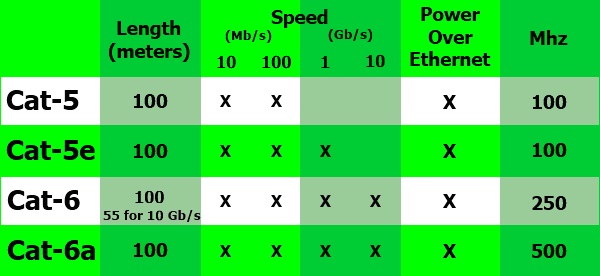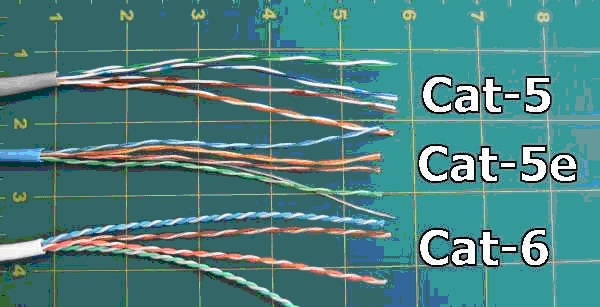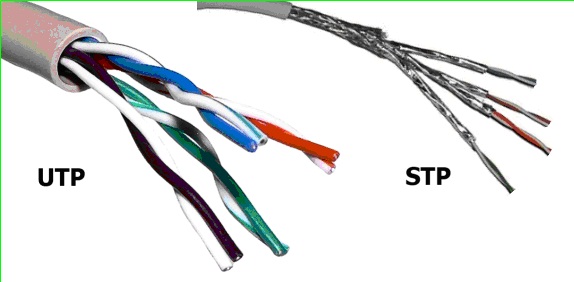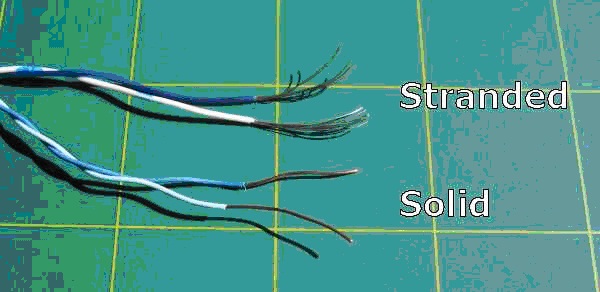The Type of Ethernet Cables
Ethernet cables are assembled into consecutively numbered categories called cat which are based on various specifications. These categories determine what types of cables are needed for specific applications. Even though they look very similar from the outside and any of them will be able to be plugged into an Ethernet port, there are some differences on the inside. There are technical and physical differences in the Ethernet cables such as; Cat-5, Cat-5e, Cat-6, Cat-6a, unshielded, shielded, stranded, or solid.
Technical Differences
There is difficulty in detecting the differences in cable specifications based on the physical structures. Categorizing helps with understanding what different cables’ specifics are. The chart below is a reference guide for applications based on the standards for that category.
As each category contains more demanding testing for eradicating crosstalk (XT) and adding isolation between the wires, the category numbers corresponds as well. As the category number goes higher, the speed and Mhz of the wire does as well.
Cat-5
Cat-5 is an older type of network cabling. The purpose was to support theoretical speeds of 10Mbps and 100Mbps. Since the cable is shorter, there might be a chance to get gigabit speeds on Cat-5 cable.
Cat-5e
Cat5-e is an improvement on Cat-5 cabling because the purpose is to support 1000 Mbps “gigabit” speeds, therefore it is faster than Cat-5. It reduces crosstalk, the interference between wires inside the cable. Due to these improvements, Cat-5e is more likely to produce faster and reliable speed. The operating temperature for CAT-5e cable is 14°F to 140°F (10°C to 60°C).
Cat-5 and Cat-5e both have 100 ohm threat and electrical characteristics in which it supports transmissions up to 100 MHz. The difference between CAT-5 and CAT-5e show in all aspects of performance: capacitance, frequency, resistance, attenuation, and NEXT.
Cat-6
Cat-6 includes more improvements from Cat-5. It has stricter specifications concerning interference and is some circumstances it is capable of 10-Gigabit speeds.
For constant transferring of data over the network, Cat-5 and Cat-6 will provide the best results. Cat-5e stranded cable is best when needing to patch cords up to 25 feet as it provides ease of flexibility.
Physical Differences
Through wire twisting and isolation, the physical cable eliminates interference and allows for quicker speeds. Twisted pair is the basis for all Ethernet cables to take out interference between internal wires (XT), and external wires (AXT). There are two major physical differences between Cat-5 and Cat-6 cables; the number of twists per centimeter in the wire and sheath thickness.
The length of the cable twisting is not standardized but usually there are 1.5-2 twists per cm in Cat-5(e) and 2+ twists per centimeter in Cat-6. In a single cable, each of the colored pair has a different twist lengths based on prime numbers so no two twists will align. The cable manufacturer determines the amount of twists per pair.
Most Cat-6 cables contain a nylon spline to help get rid off crosstalk. Even though the nylon spline helps decrease crosstalk in the wire, the thicker sheath protects against near end crosstalk (NEXT) and alien crosstalks (AXT) which both occur more general as the frequency (Mhz) rise.
Shielded (STP) vs. Unshielded (UTP)
Due to the twisted Ethernet cables, shielding can add extra protection to the cable from interference. Unshielded twisted pairs have twisted insulated copper conductors contained in a single sheath. UTP can be used for cables between the computer and the wall but it is better to use shielded cables for regions with high interference. There are various ways in shielding an Ethernet cable, but usually it is putting a shield around each pair of wire in the cable. Doing so protects the pairs from crosstalk internally.
Solid vs. Stranded
Solid and stranded Ethernet cables attribute to the actual copper conductor in the pairs. Solid cable consists of a single piece of copper for the electrical conductor whereas stranded consists of a series of copper cables twisted together. Stranded cable is more flexible therefore can be used at settings where cables will be moved around frequently. Solid cable is not as flexible but it is more durable and better electrical performance making it ideal to be used in permanent installations.
10BASE-T, 100BASE-T, 1000BASE-T
10BASE-T is the IEEE standard that defines the requirement for sending information at 10 Mbps on unshielded twisted-pair cabling, and defines various aspects of running Ethernet on this cabling.
100BASE-T is the IEEE standard that defines the requirement for sending information at 100 Mbps on unshielded twisted-pair cabling, and defines various aspects of running baseband Ethernet on this cabling.
1000BASE-T (also called gigabit Ethernet) is the IEEE standard that defines the requirement for sending information at 1000 Mbps on unshielded twisted-pair cabling, and defines various aspects of running baseband Ethernet on this cabling.








